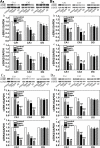Developmental iodine deficiency resulting in hypothyroidism reduces hippocampal ERK1/2 and CREB in lactational and adolescent rats
- PMID: 20021662
- PMCID: PMC2804698
- DOI: 10.1186/1471-2202-10-149
Developmental iodine deficiency resulting in hypothyroidism reduces hippocampal ERK1/2 and CREB in lactational and adolescent rats
Abstract
Background: Developmental iodine deficiency (ID) leads to inadequate thyroid hormone that impairs learning and memory with an unclear mechanism. Here, we show that hippocampal extracellular signal-regulated kinase (ERK1/2) and cAMP response element-binding protein (CREB) are implicated in the impaired learning and memory in lactational and adolescent rat hippocampus following developmental ID and hypothyroidism.
Methods: Three developmental rat models were created by administrating dam rats with either iodine-deficient diet or propylthiouracil (PTU, 5 ppm or 15 ppm)-added drinking water from gestational day (GD) 6 till postnatal day (PN) 28. Then, the total and phorsporylated ERK1/2 and total and phorsporylated CREB in the hippocampus were detected with western blot on PN14, PN21, PN28 and PN42.
Results: The iodine-deficient and hypothyroid pups showed lower serum FT3 and FT4 levels, smaller body size, and delayed eyes opening. The mean number of surviving cells in the hippocampus of the iodine-deficient and 15 ppm PTU-treated rats was significantly reduced compared to controls (P < 0.05). Iodine-deficient and 15 ppm PTU-treatment groups demonstrated significantly lower level of total and phosphorylated ERK1/2 and CREB than the controls on PN14, PN21 and PN28 (P < 0.05, respectively). The reduction of ERK1/2 and CREB was not reversible with the restoration of serum thyroid hormone concentrations on PN42.
Conclusions: Developmental ID and hypothyroidism down-regulate hippocampal ERK1/2 and CREB in lactational and adolescent rats.
Figures





Similar articles
-
Developmental iodine deficiency and hypothyroidism impair neural development in rat hippocampus: involvement of doublecortin and NCAM-180.BMC Neurosci. 2010 Apr 23;11:50. doi: 10.1186/1471-2202-11-50. BMC Neurosci. 2010. PMID: 20412599 Free PMC article.
-
Developmental iodine deficiency and hypothyroidism impair spatial memory in adolescent rat hippocampus: involvement of CaMKII, calmodulin and calcineurin.Neurotox Res. 2011 Jan;19(1):81-93. doi: 10.1007/s12640-009-9142-x. Epub 2009 Dec 9. Neurotox Res. 2011. PMID: 19997993
-
Hypothyroidism following developmental iodine deficiency reduces hippocampal neurogranin, CaMK II and calmodulin and elevates calcineurin in lactational rats.Int J Dev Neurosci. 2010 Nov;28(7):589-96. doi: 10.1016/j.ijdevneu.2010.07.230. Epub 2010 Jul 21. Int J Dev Neurosci. 2010. PMID: 20654708
-
PKC in developmental hypothyroid rat brain.Neurol Sci. 2014 Aug;35(8):1161-6. doi: 10.1007/s10072-014-1716-6. Epub 2014 Mar 29. Neurol Sci. 2014. PMID: 24682728 Review.
-
Structural and functional alterations in the hippocampus due to hypothyroidism.Metab Brain Dis. 2010 Sep;25(3):339-54. doi: 10.1007/s11011-010-9208-8. Epub 2010 Oct 1. Metab Brain Dis. 2010. PMID: 20886273 Review.
Cited by
-
The sonic hedgehog-induced type 3 deiodinase facilitates tumorigenesis of basal cell carcinoma by reducing Gli2 inactivation.Endocrinology. 2014 Jun;155(6):2077-88. doi: 10.1210/en.2013-2108. Epub 2014 Apr 2. Endocrinology. 2014. PMID: 24693967 Free PMC article.
-
Maternal Subclinical Hypothyroidism Impairs Neurodevelopment in Rat Offspring by Inhibiting the CREB Signaling Pathway.Mol Neurobiol. 2015 Aug;52(1):432-41. doi: 10.1007/s12035-014-8855-x. Epub 2014 Sep 6. Mol Neurobiol. 2015. PMID: 25193019
-
The Impact of Carrot Enriched in Iodine through Soil Fertilization on Iodine Concentration and Selected Biochemical Parameters in Wistar Rats.PLoS One. 2016 Apr 4;11(4):e0152680. doi: 10.1371/journal.pone.0152680. eCollection 2016. PLoS One. 2016. PMID: 27043135 Free PMC article.
-
Identification of gene targets of developmental neurotoxicity focusing on DNA hypermethylation involved in irreversible disruption of hippocampal neurogenesis in rats.J Appl Toxicol. 2021 Jul;41(7):1021-1037. doi: 10.1002/jat.4089. Epub 2020 Nov 4. J Appl Toxicol. 2021. PMID: 33150595 Free PMC article.
-
Developmental iodine deficiency and hypothyroidism impair neural development in rat hippocampus: involvement of doublecortin and NCAM-180.BMC Neurosci. 2010 Apr 23;11:50. doi: 10.1186/1471-2202-11-50. BMC Neurosci. 2010. PMID: 20412599 Free PMC article.
References
Publication types
MeSH terms
Substances
LinkOut - more resources
Full Text Sources
Medical
Miscellaneous

